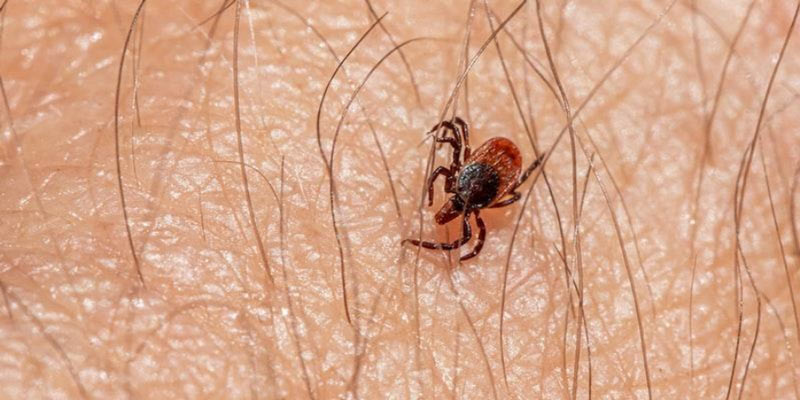Pet owners and outdoor enthusiasts worry about dog ticks. After finding a tick, Lyme disease fears frequently arise, but it's essential to know the hazards of each type. This article thoroughly covers dog ticks and Lyme disease so you can protect yourself and your family.
Dog Ticks vs. Blacklegged Ticks
Appearance and Identification
American dog ticks, sometimes known as wood ticks, are larger and flatter than black-legged ticks. Their elaborate back patterns contrast with the consistent reddish-brown look of adult female black-legged ticks and the darker body of male ticks. Nymphs, or immature ticks, are tiny and might be mistaken for other species, so be careful.
Habitats
While both tick kinds inhabit wooded and grassy areas, their preferred habitats differ slightly. Blacklegged ticks favor the cooler, moist conditions of the northern and Pacific coastal states. On the other hand, dog ticks are more adaptable, frequenting fields, forests, and even some urban areas throughout the US.
Feeding Habits
Dog ticks have a broader menu and will feed on various mammals, including humans and dogs. Blacklegged ticks, while opportunistic, tend to target white-tailed deer in their adult stage primarily. This feeding preference is why they're often called deer ticks.
Life Cycle
Both ticks have a four-stage life cycle: egg, larva, nymph, and adult. However, their active seasons may differ. Dog ticks are most active during the spring and early summer, while black-legged ticks can be active even when the temperature rises slightly above freezing.
Diseases Transmitted by Ticks
Lyme Disease
A leading vector-borne disease in the US is Lyme disease. The blacklegged tick transmits it, causing fever, tiredness, and a bull's-eye rash. Untreated infection can damage joints, heart, and nervous system.
Rocky Mountain Spotted Fever (RMSF)
This illness, transmitted by the dog tick, is characterized by symptoms that start abruptly, with high fever, severe headache, and muscle pain. The classic red, spotted rash appears a few days later. Without early treatment, RMSF can lead to severe complications.
Other Tick-Borne Diseases
Ticks are carriers of various pathogens. The lone star tick transmits ehrlichiosis, which causes fever, tiredness, headache, and muscle aches. Anaplasmosis, babesiosis, and tularemia have different symptoms and complications.
Prevalence and Statistics
While Lyme disease dominates headlines with around 30,000 reported cases yearly, other tick-borne conditions also have significant impacts. For example, annually, there are over 6,000 reported cases of RMSF.
Reducing the Risk of Tick Bites

Protective Clothing
When planning to spend time outdoors, especially in areas known for ticks, it's advisable to wear long-sleeved shirts and pants. Opting for light-colored clothing can make it easier to spot ticks before they attach.
Repellents
Tick repellents containing DEET or permethrin are beneficial in deterring these pests. Always apply repellents according to the label instructions, and conducting a patch test is recommended for sensitive skin.
Regular Checks
Post outdoor activities, a thorough body check for ticks is crucial. This helps in early detection and reduces the chance of disease transmission. Key areas to inspect include the back of the knees, armpits, scalp, and waistline.
Landscape Management
In residential areas, maintaining a well-groomed yard can help reduce tick populations. Keeping grass short, removing leaf litter, and creating barriers between wooded areas and play or recreational zones using mulch or gravel can deter ticks from entering frequently used spaces.
Educating the Community
Awareness plays a significant role in prevention. By organizing or participating in community awareness programs, individuals can share knowledge about ticks, their habitats, and the diseases they carry, thereby empowering communities to take proactive measures for dog Lyme disease vaccine.
What to Do if You Find a Tick

Safe Removal
Discovering a tick on your body can be unnerving, but swift and proper removal is paramount. To achieve this:
- Equipment: Use fine-tipped tweezers, allowing a secure grip on the tick without squeezing its body.
- Method: Position the tweezers as close to the skin's surface as possible, grasping the tick's head or mouthparts to assess the dog's Lyme disease vaccine. Pull upward with steady, consistent pressure. Avoid twisting or jerking the tick, as this can result in the mouthparts breaking off and remaining in the skin.
- Post-removal Care: After the tick is successfully detached, wipe the area with rubbing alcohol.
Document the Bite
Documentation can serve as a valuable resource if health complications arise later.
- Photograph: Take a clear picture of the tick from various angles. This can help professionals identify its species and assess potential disease risks.
- Tick Storage: Consider placing the tick in a sealed plastic bag with a damp cotton ball. If symptoms arise later, having the tick for analysis might be beneficial. Label the bag with the date and location of the bite.
- Bite Marker: Mark the date and location of the bite on your calendar or a personal health journal. This will be a reminder to monitor for symptoms in the ensuing weeks.
Monitor for Symptoms
Different treatments for Lyme disease in dogs and tick-borne diseases manifest with various symptoms, so vigilant observation is essential.
- Initial Indications: Common symptoms of tick-borne diseases include fever, fatigue, and muscle aches. These can appear within days or weeks following a tick bite.
- Specific Signs: Some diseases have distinct markers. The bullseye rash indicates Lyme illness, while the patchy rash indicates Rocky Mountain Spotted Fever. Even if you don't have these symptoms, see a doctor if you feel sick following a tick bite.
- Duration: For many tick-borne diseases, symptoms can last for varying durations. While some people might recover within weeks, others might experience lingering symptoms for months. In such situations, termed post-treatment Lyme disease syndrome in the case of Lyme disease, ongoing medical care and monitoring become even more essential.
Seek Medical Advice
If you observe symptoms or are unsure about the removal process, seeking prompt medical attention is crucial.
- Consultation: Discuss the tick bite, the species (if known), how long it might have been attached or to treatment for Lyme disease in dogs and any symptoms you've noticed.
- Treatment: If a healthcare provider suspects a tick-borne disease, they may prescribe medications or other medicines. Early intervention can prevent complications and more severe manifestations of the disease.
- Follow-up: Adhere to any medical advice, attend follow-up appointments, and immediately report any new or worsening tick repellent for dog symptoms.




